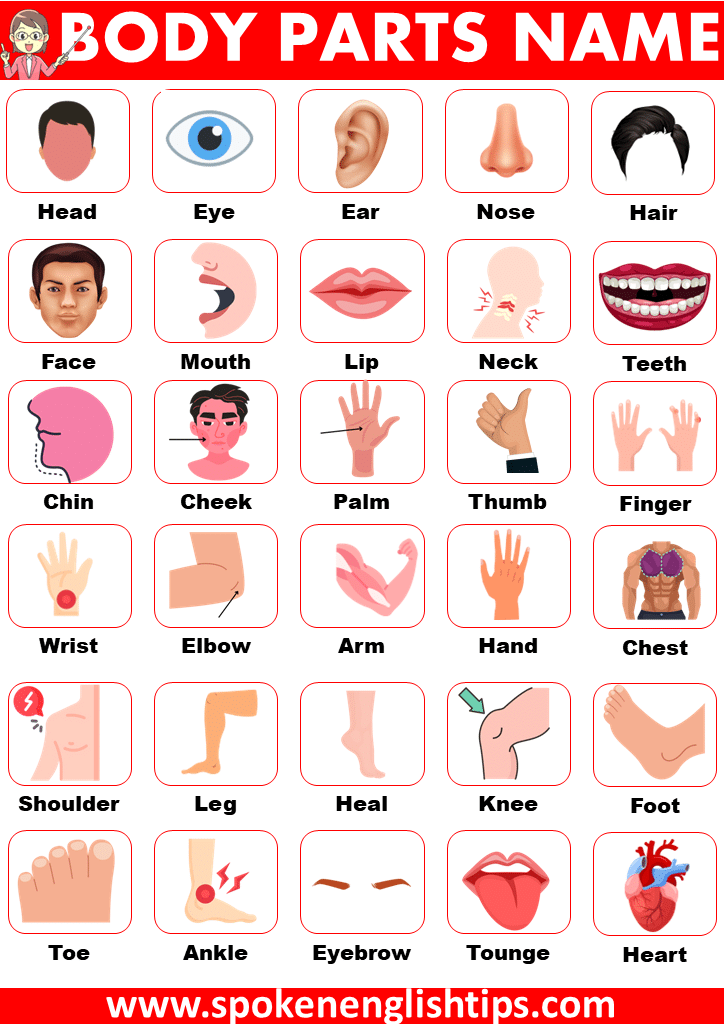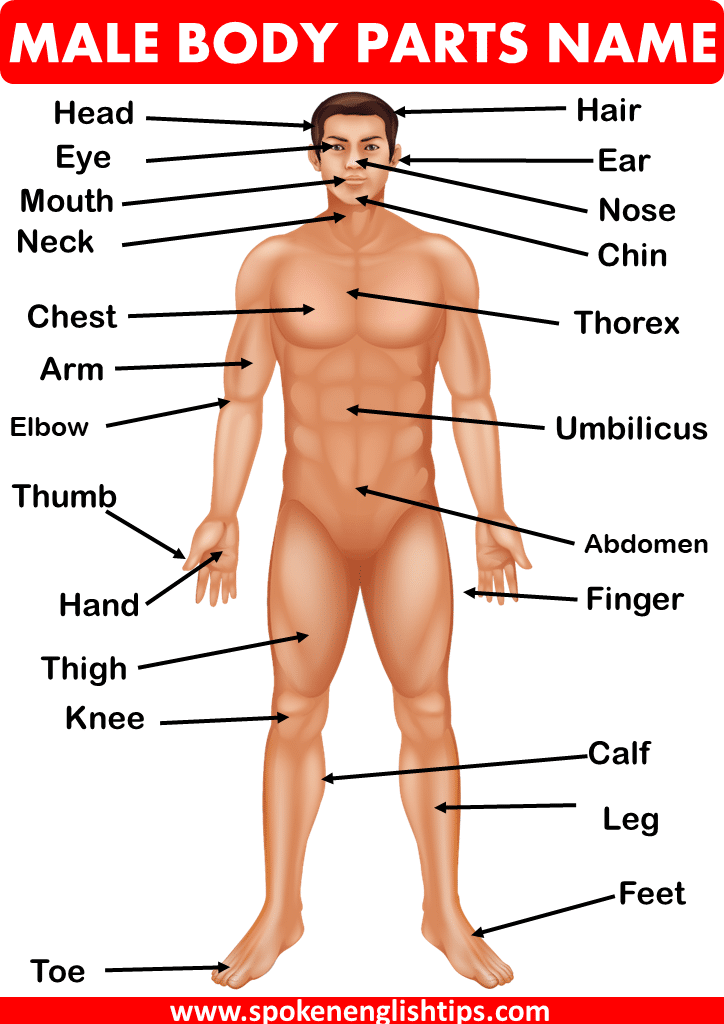Are you looking for body parts name in english with pictures? Here is the complete list of body parts names that will enhance your vocabulary and knowledge power. Every part of our body plays an important role in our health and well-being.
As we go about our day, our body enables us to perform various activities with ease. Each body part has its own unique function and when they work together, they allow us to complete tasks effectively.
The human body is composed of different parts, including organs, that work together in harmony to achieve common goals. This entire system of body parts is collectively referred to as the human body.
Almost of people don’t what is all the organ’s names in our body and this is quite wrong. We must aware of the names of all parts of our body.
Body Parts Name
The human body is made up of tiny building blocks called cells. These cells come together to form tissues, and a group of tissues forms organs. Different organs work together to form systems that help the body function properly.
There are many different parts of the human body, which can vary depending on the system being studied. The study of these parts is called anatomy.
There are 79 organs (Wikipedia) in the human body, but there are five that are extremely important for survival: the brain, heart, liver, lungs, and kidneys. If any of these organs are damaged, it can result in the end of a person’s life.

The human body consists of many different parts and structures that work together to help us move, breathe, and function.
The head is at the top of the body and contains the brain, eyes, ears, nose, and mouth. The neck connects the head to the rest of the body. The torso includes the chest, abdomen, and pelvis.
The arms are attached to the torso and have hands with fingers for grasping and manipulating objects. The legs are attached to the pelvis and have feet with toes for walking and balance.
The skeleton provides structure and support, while muscles enable movement. The circulatory system carries blood throughout the body, while the respiratory system helps us breathe.
Human Body Parts Name with Pictures
| Sr. No | Image | Body Parts Name |
|---|---|---|
| 1 |  | Head |
| 2 |  | Eye |
| 3 |  | Ear |
| 4 |  | Nose |
| 5 |  | Hair |
| 6 |  | Face |
| 7 |  | Mouth |
| 8 |  | Lip |
| 9 |  | Neck |
| 10 |  | Teeth |
| 11 |  | Chin |
| 12 |  | Cheek |
| 13 |  | Palm |
| 14 |  | Thumb |
| 15 |  | Finger |
| 16 |  | Wrist |
| 17 |  | Elbow |
| 18 |  | Arm |
| 19 |  | Hand |
| 20 |  | Chest |
| 21 |  | Shoulder |
| 22 |  | Leg |
| 23 |  | Heel |
| 24 |  | Knee |
| 25 |  | Foot |
| 26 |  | Toe |
| 27 |  | Ankle |
| 28 |  | Eyebrow |
| 29 |  | Tounge |
| 30 |  | Heart |
| 31 |  | Forehead |
| 32 |  | Backs |
| 33 |  | Gums |
| 34 |  | Abdomen |
| 35 |  | Waist |
| 36 |  | Belly |
| 37 |  | Pupil |
| 38 |  | Nail |
| 39 |  | Fist |
| 40 |  | Kidney |
| 41 |  | Lungs |
| 42 |  | Liver |
| 43 |  | Ribs |
| 44 |  | Stomach |
| 45 |  | Brain |
| 46 |  | Intestine |
| 47 |  | Pancreas |
| 48 |  | Thyroid |
| 49 |  | Bladder |
| 50 |  | Nerves |

Body Parts Name With Details
Head

The head is part of the body that sits on top of the neck. It contains the brain, eyes, ears, nose, and mouth, and is responsible for many important functions such as thinking, sensing, and communicating.
Hair

Hair is a strand of protein that grows on our heads. It comes in different colors and textures. It can be styled and cared for in various ways.
Ear

The ear is a part of the body that helps us hear sounds. It has three main parts: the outer ear, middle ear, and inner ear. Sound travels through these parts to reach the brain.
Nose

The nose is a body part on your face that helps you breathe and smell things. It’s made up of bones, cartilage, and skin, and comes in different shapes and sizes.
Eye

The eye is a sense organ that lets us see the world. It has a pupil that lets light in and a lens that focuses it. Blinking helps keep it moist.
Forehead

The forehead is a distinct region on the face, enclosed by three defining features – two bony prominences of the skull and one from the scalp. The upper part of the forehead is covered by hair, while the lower portion is demarcated by the supraorbital ridge, which is a prominent bone structure located above the eyes.
Cheek

The buccal nerve is located within the area known as the cheeks, which can be found beneath the eyes and between the nose and ears on both sides of the face. The vestibule, also referred to as the space between the teeth and gums surrounds this region of the cheeks.
Neck

The neck is part of the body that connects the head to the torso. It is made up of seven vertebrae and is responsible for supporting the weight of the head and allowing for movement.
Mouth

The mouth is a complex anatomical feature located on the face, consisting of the lips, teeth, tongue, palate, and other structures. It is essential for various functions, including speech, eating, and breathing.
Chin

Chin refers to a body part, specifically the area below the lower lip and above the jawline. Some people choose to get tattoos or piercings on their chin for aesthetic or cultural reasons.
Shoulder

- The shoulder is the joint connecting the arm to the torso.
- Shoulders are essential for many daily activities, such as lifting, carrying, and reaching.
- Shoulder pain and injuries can limit mobility and require medical attention.
- Proper posture and exercises can help prevent shoulder problems and maintain shoulder health.
Chest

- The chest, also known as the thorax, houses important organs like the heart and lungs.
- A sturdy chest can be built through regular exercise that targets the pectoral muscles.
- The chest is often associated with bravery and courage, as in the phrase “puffing out one’s chest.”
Arm

- The arm is a limb extending from the shoulder to the hand.
- Arms are used for a variety of activities, such as lifting, reaching, and carrying.
- The arm contains muscles, bones, and joints that allow for movement and flexibility.
- The upper arm bone is called the humerus, while the lower arm contains the radius and ulna bones.
- The arm is a vital part of the body that enables us to perform numerous daily tasks with ease.
Elbow

Elbow is a joint that connects the upper and lower arm bones. It allows for flexion and extension, as well as rotation of the forearm. The elbow is important for many activities, such as lifting and throwing, and is prone to injury in athletes and manual laborers.
Abdomen

- The abdomen is the area between the chest and the pelvis.
- The abdominal muscles help support the spine and protect the organs.
- Digestive organs such as the stomach, intestines, and liver are located in the abdomen.
- Abdominal pain can be caused by a variety of conditions, including digestive issues and organ damage.
- Abdominal exercises can help strengthen the core muscles and improve posture.
Hand

- The hand is a complex and versatile part of the human body, capable of intricate movements and sensory experiences.
- Our hands are essential tools for communication, expression, and creativity.
- With the use of our hands, we can manipulate objects, create art, and perform intricate tasks.
Thumb

- The thumb is the shortest and most opposable digit on the human hand.
- It plays a critical role in grasping and holding objects.
- The thumb has its own unique set of muscles and tendons.
- In some cultures, the thumb symbolizes good luck or success.
Finger

- Fingers are crucial for grasping and manipulating objects with precision.
- They are made up of bones, muscles, and tendons, allowing for a wide range of movements.
- Fingers can be used for communication through sign language or typing on a keyboard.
Knee

- The knee joint connects the thigh bone (femur) to the shinbone (tibia).
- The knees provide stability and flexibility to the lower body.
- The knee joint is a hinge joint that allows for the bending and straightening of the leg.
Calf

The calf muscle is a complex group of muscles located on the back of the lower leg. It consists of the gastrocnemius and soleus muscles, which are responsible for plantar flexion and stabilization of the ankle joint. The calf muscle is essential for walking, running, and jumping.
Foot

The human foot contains numerous organs such as bones, muscles, tendons, ligaments, nerves, blood vessels, and skin. These organs work together to provide support, balance, movement, sensation, and protection to the body. The foot also has sweat glands, which help regulate body temperature, and fat pads, which cushion the foot against pressure and shock.
Leg

The leg has several essential organs, including bones, muscles, tendons, ligaments, and nerves. The largest organ in the leg is the thigh bone (femur), which connects to the knee joint. The calf muscle (gastrocnemius) is also an important organ that helps with movement and stability.
Read Also:
- Best Descriptive Words
- Sounds of Animals List with Words
- 100 Sea Animals list
- Girls Dress name
- 25+ Dry Fruits Names
- Fruits and Vegetables